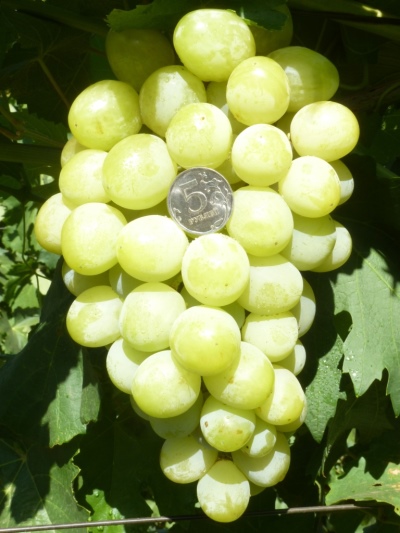
- Authors: Gusev Sergey Eduardovich
- Appointment: dining room
- Berry color: White
- Taste: nutmeg
- Ripening period: very early
- Frost resistance, ° C: -24
- Bunch weight, g: 800-1200
- Flower type: functionally female
- Density of the bunch: moderate density
- Skin: medium
Gina is an early grape variety for table use with vigorous, own-rooted bushes. The variety is very popular with winegrowers for its excellent taste and high consumer demand.
Breeding history
The author of the young hybrid is the Russian breeder Sergey Eduardovich Gusev. He chose Blagovest and Super-Extra as parent varieties. As a result, a high-yielding offspring with excellent organoleptic and biological characteristics was obtained, and it can be safely called original, so it does not taste like the parent varieties.
Geography of distribution
The tested variety is zoned for the central and northern regions of central Russia, and these are the Volgograd and Moscow regions, Novgorod and Smolensk regions, Tula, Tver and Yaroslavl. The same list includes the Volga region and the southern regions of the black earth. Confident frost resistance made it possible to cultivate it in the Urals and Siberia.
Description
An early ripening hybrid has vigorous bushes with powerful shoots that need to be formed. Gina has excellent taste and decorative qualities, which makes it very popular in the market. Used for fresh consumption, excellent in preservation (juices, compotes, jams and preserves). Rich in vitamins and amino acids.
Ripening period
While the variety is on trial, there are no exact official data, but the hybrid is very early. According to information received from gardeners, the approximate dates for reaching technical ripeness are in the area of late July - early August. It all depends on the region of growth. In the subtropical climate of the Black Sea coast, the timing may shift closer to mid-July.
Bunches
Large conical clusters are regular in shape, sometimes with a lateral branch in the form of a wing. The average mass of moderately dense brushes is 800-1200 g, but, according to the originator, on large formations with a large supply of perennial wood, more impressive clusters are obtained, the mass of which can reach 2 kg. However, according to S. E. Gusev, too much weight does not have a very good effect on marketability, since heavy brushes are more expensive than medium ones. With the correct normalization, peas are not observed.
Berries
Very large oval-shaped fruits weighing 16-18 g of white, or rather, light green color, when fully ripe, give off amber shades, have a fleshy-juicy crispy pulp surrounded by a medium-density skin. Berry size - 28x30 mm, sugar content up to 220-230 g / dm³.
Taste
Gina has a harmonious, sweet taste with a strong nutmeg flavor and aroma, as well as a slight sourness. It has a long-lasting floral aftertaste.
Yield
According to the declared characteristics, the hybrid gives high yields under good conditions and proper agricultural technology.


Growing features
Gina is a hybrid with standard requirements, it is enough to follow the generally accepted norms for growing vines and the bushes will give a stable harvest.
Landing
Vigorous bushes with powerful shoots require a sufficient distance between them - 1.5 m, and 2 m between the rows. Pits for planting seedlings - 80x80x80 cm. Gravel or broken brick is laid at the bottom for drainage, then soil enriched with organic matter and mineral fertilizers is poured. The roots of the seedling are gently spread over the surface and covered with soil, leaving the root collar open. The trunk circle is well spilled, after 1-2 days the soil is loosened and mulched.

Pollination
The hybrid blooms functionally with female flowers, and nearby bushes with male flowers are needed, but the pollination rates are quite high.
Pruning
Recommended long (8-10 eyes) or medium (6-8 eyes) pruning of shoots.

Watering
Like all grape varieties, Gina does not like waterlogging. It will require standard watering in the absence of rain: 3-4 times per season up to 6 buckets under a bush.


Frost resistance and the need for shelter
The hybrid can withstand frosts down to -24 °, but shelter for the winter in temperate climates is mandatory for him.

Diseases and pests
Due to its very early ripening period, the form is practically not affected by fungal diseases. As a preventive measure, spraying with fungicides or copper sulfate is necessary. Experts advise Cabrio Top as one of the best universal preparations for fighting mildew and powdery mildew. Pathogenic organisms do not develop resistance to it.

If a grape is exposed to any disease or insect, this always affects its appearance.
Storage
The bunches have good transportability, they are well tolerated for long-distance transportation. Refrigerated and cool storage is possible from several weeks to several months.











































































